Malta - January 2008

I saw a cheap deal in January to Malta and flew over to spend a few days on the island.
The Maltese islands are the peaks of submerged mountains. Around 6000 years ago an earthquake tilted the islands, so the northern coastline slopes gently to the sea and the southern coast has some dramatic cliffs.
Malta has a fascinating history. Around 5000BC humans came from Sicily to the islands. The population grew and many temples and shrines were built. The most famous of these is the Hypogeum, that I'll write about in detail later.
More settlers arrived during the bronze age, followed by Phoenicians, Carthaginians, Romans and Byzantines.
Arabs took over Malta in medieval times and the Maltese language is derived from Arabic.
In 1090 Roger the Norman captured Malta and gave the Sicilian bishop jurisdiction over the islands. Numerous power struggles and empire building marriages later the Order of St. John set up a base for the Knights of Malta.
In 1565 the Ottoman Turks attacked in what became known as the Great Siege. Against all odds the Knights were victorious, and their Maltese base gave them control of the seas of the central Mediterranean.
The arrival of Napoleon Bonaparte in 1796 finally ended the Knights rule but his conquest was short lived. In just three months the French looting and theft of valuable and sacred artefacts angered the Maltese and they asked for help from the British. In 1814 the Maltese islands became a British Crown Colony.
The strategic location of Malta was invaluable to the British in World War I and II. During the Second World War, Malta's strategic position enabled her to strike at the Axis forces in the Mediterranean, disrupting their operations in North Africa and elsewhere.
The ship-repairing facilities were invaluable to the British Fleet. Malta had to be defended but the early months saw much damage as the islands' inadequate air defences comprised of three aged Gloster Gladiator biplanes which the locals immediately christened Faith, Hope and Charity. Defences were eventually upgraded with the arrival of Hurricane and Spitfire fighters. Less than 24 hours after Italy entered the war in June 1940 the first air-raids by the Italian Air Force occurred, which then increased with the involvement of the Luftwaffe.
Through 1941 and 1942 Malta was the most heavily bombed place on earth. As the convoys carrying precious supplies were attacked and sunk, the islanders suffered serious deprivation and disease. The arrival of the battered remains of a convoy on the 15th August 1942 was ascribed by the inhabitants to a miracle, interceded by the Virgin, on whose Feast of the Assumption it occurred.
In April 1942 King George VI, in a dramatic and unprecedented gesture, conferred the George Cross on the tiny Mediterranean island. The news of the award of the George Cross was internationally welcomed as it served in a tangible way to mark the heroism of all concerned. A depiction of the George Cross was added to the Maltese national flag soon after the award was made and the honour is still proudly borne today by the Maltese as their flag is raised outside the European Parliament Buildings in Brussels.
After WWII Malta very nearly became integrated into Britain, only parliamentary procrastination led to Malta's independence in 1964. Now modern Malta in part of the European Union and uses the Euro.
I stayed in St Julians at the Bay Street hotel. A nice hotel, apart from the endless noise from the restaurants, bars and clubs nearby. I was unlucky enough to have a room overlooking the Hard Rock Cafe, pumping out loud music until 2am each morning.
On my first day in Malta I took a tour bus around the island, to familiarise myself with the sites and also to visit the Hypogeum. Many of the temples were closed for renovation but I was very lucky to get to see the Hypogeum as only a limited number of visitors are allowed each day.
Malta's sightseeing bus starts in Sliema, passing through Valletta and on to the Hypogeum.
The Hypogeum was allegedly discovered in 1899 by builders digging the foundations for a new house, but the find was not reported until 1902 (after the house was finished).
The site's lighting, temperature, relative humidity and carbon dioxide levels are constantly monitored to ensure the Hypogeum’s survival for future generations. Many people are in awe of this prehistoric site but I confess I was a little disappointed; the bare metal stairway and handrails that ran through the site clashed with the ancient carved rocks and snaking power cables destroyed the mood for me. Also no photography was allowed; the use of flash I could understand but surely there can't be a problem taking photos in the ambient lighting?
The photo shown here was taken from another website so you can see the nature of the Hypogeum.
A short walk from the Hypogeum is the Paola Church of Christ the King.
Jumping back on the bus I passed through Vittoriosa, south to Marsaxlokk, west along the south coast to Ħaġar Qim (unfortunately closed) and on to Siġġiewi before heading back to Sliema.
The next day I took a trip to Marsaxlokk, the Blue Grotto and Limestone Heritage. Unfortunately the promised Blue Grotto boat trip wasn't available due to the weather. The area where the Blue Grotto boats trips depart from is called Wied iz-Zurrieq; there are some fine views of the cliffs and the tiny island of Filfla.
Filfla is a crumbling flat-topped limestone plateau surrounded by 60 metre high cliffs 3 miles from the coast. The only known permanent structure on it was a chapel built inside a cave in 1343, which was destroyed by an earthquake in 1856 that also sank part of the island. Until 1971 the Royal Navy and Royal Air Force used the island for target practice. It became a bird reserve in 1980.
Next was the Limestone Heritage tour, a family run living exhibition located in the outskirts of the village of Siggiewi, one of the main quarrying districts in Malta. Limestone is the primary building material in Malta as you can see from the rich golden colours of the buildings.
Our final stop was Marsaxlokk, the main fishing town with a small flea market.
I have to marvel at the people that write the guide books. In the 'Rough Guide', author Victor Paul Borg says 'ignore the uninspired souvenirs in favour of the incredibly fresh fish.'
Can someone please tell me what a tourist is going to do with fresh fish? I don't believe you can walk into a local restaurant and have it prepared and cooked for you. You certainly can't take it back to stink out your hotel room, or take it home with you.
Marsaxlokk does have an attractive church and a lovely statue of St Andrew in limestone.
My next day of discovery was to and around Valletta.
Valletta is the capital city of Malta and is surrounded on 3 sides by sea. Its history is that of the Knights of Malta who planned and built the town that became Malta's capital.
On the way to Valletta you pass through the Porta Reale (Kingsway) City Gate, and shortly after that pass by the church of St. Plubius. During World War II the church was hit by several bombs; 13 people died when the dome and roof collapsed crushing people sheltering from the bombs in the crypt. I'm impressed by the reconstruction.
Malta has great and colourful yellow/orange buses, they are inexpensive and they almost all end up at the bus terminus by the Triton Fountain. The buses are a tourist attraction in their own right, many being old post war Leylands with name like the Lion and Tiger Cub. Most of the buses are privately owned by the driver. I just hope the European Union doesn't pass some directive requiring disabled access and wheelchair ramps or these great buses will disappear forever, like the old London Routemasters that used to carry people all over London.
Another of Malta's claims to fame is the Maltese Falcon. In Freedom Square, close to the Triton Fountain and bus terminus, you'll find a wonderful monument to the Maltese falcon in gold.
In the thirteenth century Fredrick II, king of Sicily, decided that Maltese peregrine falcons were the best. Their fame spread and when the Knights were granted the islands in 1530 the Emperor Charles V of Spain asked for just one Falcon a year in payment.
The powerful symbolism of the Maltese Falcon became the inspiration for Dashiell Hammett who created a 1930's detective thriller based around the theft of a golden, jewel encrusted statuette of a falcon supposedly a gift from the Knights to the Emperor. Once the movie, starring Humphrey Bogart, hit the screens the Maltese Falcon was a mainstream public idea.
Unfortunately black market trappers and hunters, enticed by the legendary birds, succeeded in making the Maltese peregrines extinct in 1982.
Entering Valletta you find the tourist office in Freedom Square and Republic Street, the main shopping street that runs to Fort St Elmo.
The National Museum of Archaeology is located on the left side as you walk down Republic Street in the the Auberge de Provence building.
St. Johns Co-Cathedral was built by the Knights of Malta between 1573 and 1578 as the church of the Order of the Knights Hospitaller of St John. St John’s Co-Cathedral is a gem of Baroque art and architecture. The Grand Masters and several knights donated gifts of high artistic value and made enormous contributions to enrich it with the best works of art.
The massive vault is painted by Mattia Preti, illustrating episodes from the life of St. John the Baptist. The spacious nave is flanked on either side by the chapels of the various Langues of the Order. Both the church and its oratory are paved with marble tomb-stones, under which lie the remains of the knights. There are altogether 364 slabs, all of which bear Latin inscriptions exalting the merits and deeds of the Knights of the Order. The Oratory, which forms part of the Church, is noted for Caravaggio's masterpiece 'The Beheading of St. John'. Another excellent Caravaggio painting, 'St. Jerome', can be seen at the Chapel of Italy inside the Church.
For an uninterrupted view of the Grand Harbour, the Upper Barrakka Gardens date from the Knights time on the island and now feature a number of monuments to personalities such as Lord Strickland, a former Prime Minister of Malta.
From the Upper Barrakka Gardens you can see the 10 ton bronze Great Siege Bell. This was inaugurated in 1992 by Queen Elizabeth II and the President of Malta, as a memorial to those who lost their lives in the Siege of Malta during 1940 - 1943. It is rung daily at midday. There are fine views from here across to Malta's Grand Harbour to the Three Cities of Senglea, Vittoriosa and Kalkara. The Grand Harbour has played a major part in Malta's history. It is deep, sheltered and bordered by high stone bastions. Although now quiet and peaceful, it has been the location for fierce battles over the years and was the site of ferocious bombings and huge destruction in World War II.
Below the Upper Barrakka Gardens is The Saluting Battery, another of the surviving architectural structures of the Knights of St. John. It was built in the 16th century as part of Valletta’s main defences and was in use up until as recently as 40 years ago. You can look down upon it from the Upper Barrakka Gardens and hear the noon day gun fired or for a chance to load one of the old cannons yourself, for a small charge you can enter the battery itself.
The area also has fine views of the Grand Harbour.
My next day in Malta included a tour of the Three Cites. Across the Grand Harbour from Valletta is the area known as the Three Cities: Senglea, Cospicua and Vittoriosa. Driving past Cospicua to Vittoriosa we stopped to walk through the various narrow streets shaded by historic buildings and churches. A harbour cruise in a ‘fregatina’ was included. In Senglea we saw the ‘Vedette’ placed in the centre of the Grand Harbour.
The Vedette is an old lookout point in Safe Haven Garden, Senglea. It is famous for its sculpture of eyes and ears on the exterior walls, a warning that the enemy can be seen and heard; and has views over the Grand Harbour to Valletta.
Senglea itself is the smallest of the Three Cities. Its strategic position at the centre of the Grand Harbour made Senglea the most heavily bombed part of Malta during the Second World War.
My last day was a trip to Mdina, the 'old capital' of Malta. Mdina is a medieval town, with narrow quiet streets, situated in the centre of the island. It is also known as the "Silent City".
The Cathedral of St. Paul was built from 1697 to 1702 to replace a Norman cathedral that had been destroyed by earthquake in 1693. The new cathedral caused a significant redesign of medieval Mdina's city centre—several streets and houses were cleared to create an open square in front of the cathedral.
My short winter visit only scratched the surface of Malta's history, as some sites were closed and others I didn't have a chance to see (such as the island of Gozo).

A 'stock' photo of the Hypogeum

Paola's Church of Christ the King
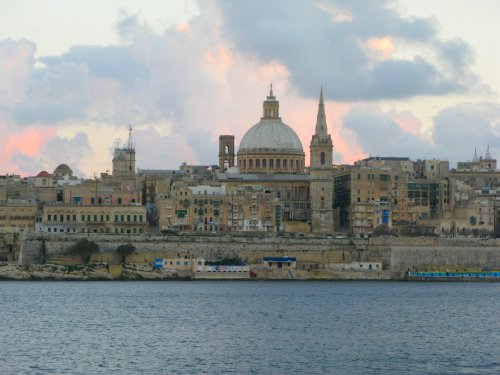
Valletta in the evening light
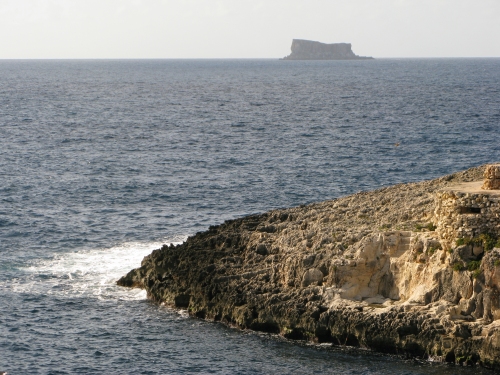
The island of Filfla seen from Wied iz-Zurrieq

The cliffs at Wied iz-Zurrieq

The church at Marsaxlokk
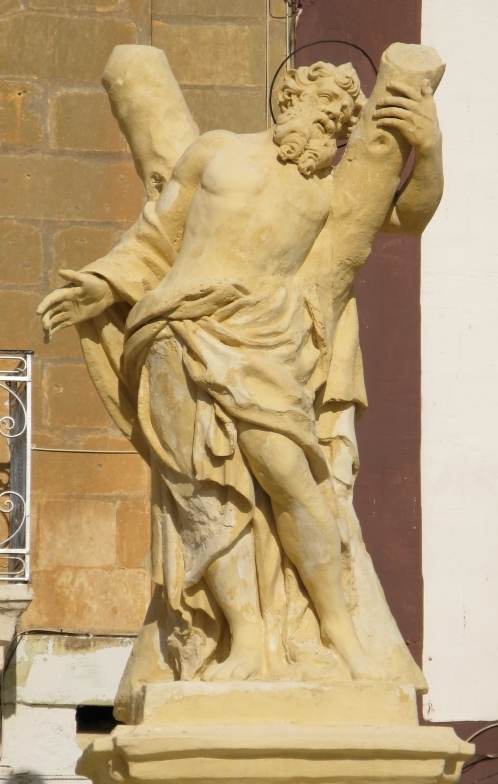
St Andrew, patron Saint of fisherman, in the square
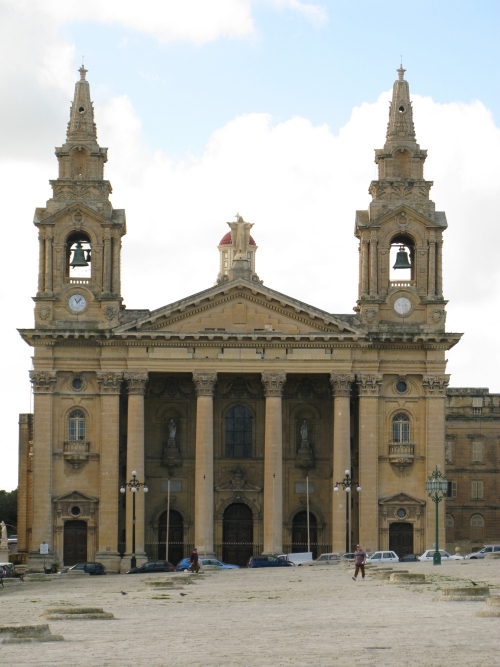
The church of St. Plubius in Floriana
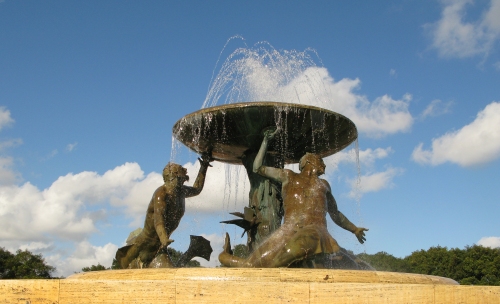
The Triton Fountain outside the city gate and bus terminus
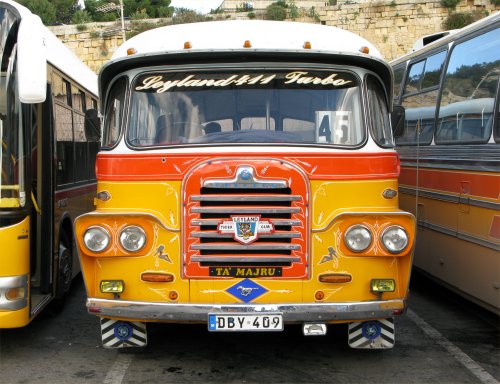
One of Malta's colourful buses
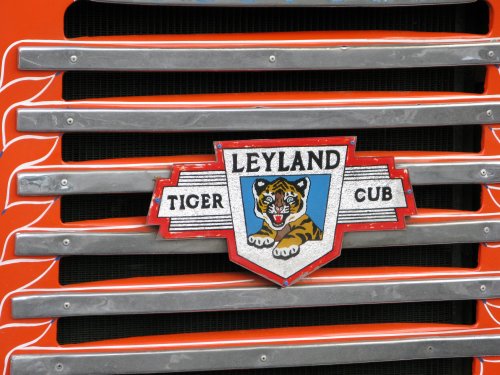
The Leyland 'Tiger Cub'

The Golden Maltese Falcon
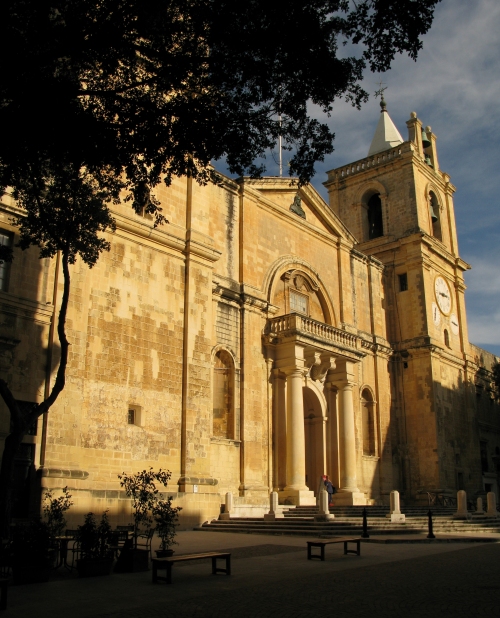
St. John's Co Cathedral

The Upper Barrakka Gardens
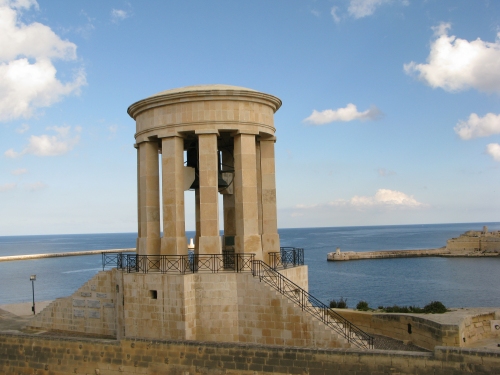
The Siege Bell
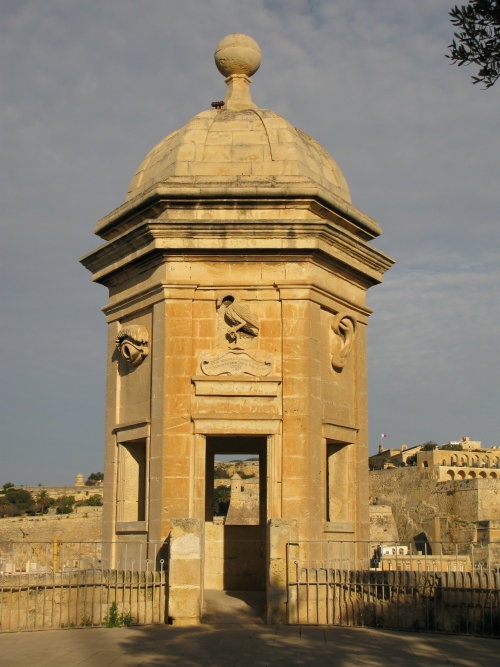
The eye and ear of the Senglea Vedette

Mdina

St. Paul's Cathedral in Mdina.